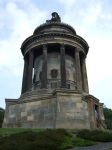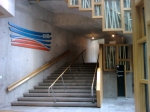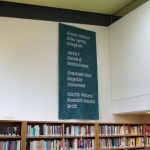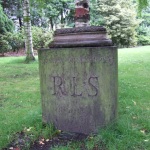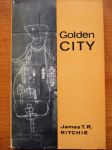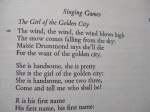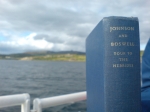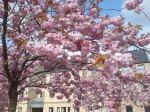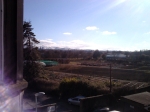N is for Netherbow

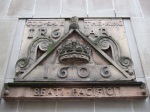


The Netherbow Port was one of six entrances to Edinburgh until it was demolished along with the old city walls in 1764. It was here the Jacobite Army under Bonnie Prince Charlie forced their way into the city in 1745. Today near where it stood is the Scottish Storytelling Centre; it incorporates an inscription from 1606 for James VI, BEATI PACIFICI (blessed are the peacemakers), and a bell commissioned by ‘the senate and people of Edinburgh’ from Holland in 1621. Near the bell is a modern rendering of the motto of James and the other Stuart monarchs, NEMO ME IMPUNE LACESSIT / wha daur meddle wi me.
In 1633, on the occasion of Charles I’s coronation at Holyrood, the whole city was turned into a vast theatre (why does that sound familiar?), with visuals by the painter George Jameson of Aberdeen, and texts by the poet William Drummond of Hawthornden. At the Netherbow Port, there was, according to Drummond’s biographer David Masson, an “arch, with stage, mottoes, canvasses and what not, representing Heaven itself, with stars of all magnitudes, the Earth beneath and the Titans prostrate on it, the Fates, and the Seven Planets, each sitting on a throne, and Endymion among them.”
O is for Ossian
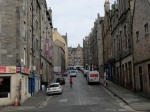
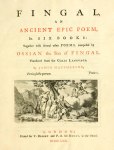


Blackfriars Street runs unassumingly between the Cowgate and the High Street. It was created in 1867 after the demolition of Blackfriars Wynd, where in 1507 the first printing press in Scotland had been set up by Chepman and Myllar. Here in 1762 James Macpherson translated – or wrote – Fingal, one of the most popular and influential works of early Romanticism.
The poems of Ossian were hugely popular in the late 18th and early 19th centuries, widely read in Britain and across Europe, influencing landscape design (especially Scottish follies), the early work of Goethe, and Napoleon, who carried a copy with him on campaign. Presented as prose translations of ancient Gaelic poetry made by James Macpherson, they contained more of the latter than the former.
Macpherson (1736–1796) was a Gaelic speaker from Ruthven in Inverness-shire. He began collecting oral poetry in Gaelic from his home area, popularly considered to be by the legendary bard Ossian, and continued collecting while employed as a tutor by Graham of Balgowan in Perthshire. Here he met the philosopher and historian Adam Ferguson (also a Gaelic speaker), and the minister and playwright John Home, who asked him to translate some Gaelic poems. Macpherson was at first reluctant, but his Fragments of Ancient Poetry (1760) was hugely successful, and he was then funded by the Edinburgh literati to look for what they hoped would be a Scottish epic to rival the Iliad.
Macpherson’s greatest champion was Hugh Blair (1718–1800), a Church of Scotland minister who in 1760 was appointed Professor of Rhetoric at Edinburgh University (and who spoke no Gaelic). In 1762 he invited Macpherson to Edinburgh, and there he composed much of his next book, Fingal, in Blackfriars Wynd, in an apartment directly below Blair’s lodgings. The following year Blair wrote ‘A Critical Dissertation on the Poems Of Ossian, the Son of Fingal’, included in every edition of Ossian after 1765: ‘We may,” he wrote, boldly assign Ossian a place among those whose works are to last for ages.’
Blair described Ossian as “the only poet who never relaxes”. While Macpherson’s language and imagery may have been revelatory and innovative at the time, his work is hard to read at any length now. Even at the time Macpherson had his detractors: Boswell records Samuel Johnson saying, ‘I look upon M’Pherson’s Fingal to be as gross an imposition as ever the world was troubled with. Had it been really an ancient work, a true specimen how men thought at that time, it would have been a curiosity of the first rate. As a modern production, it is nothing.’ (Journal of a Tour to the Hebrides, 22 September 1773)
Below is a brief extract from Fingal.
‘As the troubled noise of the ocean when roll the waves on high: as the last peal of the thunder of heaven, such is the noise of battle. Though Cormac’s hundred bards were there to give the war to song; feeble were the voices of a hundred bards to send the deaths to future times. For many were the falls of the heroes; and wide poured the blood of the valiant.’
Blair’s memorial is in Greyfriars Kirkyard. François Gérard’s painting ‘Ossian Evoking the Spirits on the Banks of the Lora to the Sound of His Harp’ (c.1811) hangs in the Hamburger Kunsthalle.
P is for Parliament
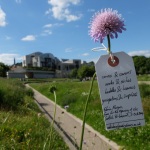

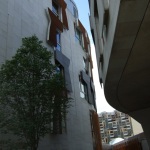
Scotland’s parliament – abolished with the Act of Union in 1707– was restablished in 1999. It met at the Assembly Hall on the Mound, while a new building was being constructed. Designed by the Catalan architect Enric Miralles, who died in 2000, it opened on 9 October 2004. On that day a poem was read, written by Edwin Morgan, the Scottish Makar, or national poet. He lived in Glasgow, was in his 80s, and not in good health, so he wasn’t able to visit the building. He wrote from photos, and plans, and people’s descriptions, but he gives a very accurate description of the building and its variety. The poem is in three parts: the first describes the building, the second describes its place in Edinburgh, and in Scottish history, and the third looks to what we might expect in the future from the new parliamentarians. This is from the first part.
‘Did you want classic columns and predictable pediments? A growl of old Gothic grandeur? A blissfully boring box?
‘Not here, no thanks! No icon, no IKEA, no iceberg, but curves and caverns, nooks and niches, huddles and heavens, syncopations and surprises. Leave symmetry to the cemetery. But bring together slate and stainless steel, black granite and grey granite, seasoned oak and sycamore, concrete blond and smooth as silk – the mix is almost alive – it breathes and beckons – imperial marble it is not!’
Features on the building’s exterior include the so-called ‘bamboos’, which in fact are staves of oak. Miralles grew up in the 1950s and 60s in Spain under facism; the facist emblem is a bundle of sticks bound tightly together, and my sense is that these are those sticks unbound. That’s the difference between facism and democracy – here each stick has its own individual space. The ‘trigger panels’ can be seen as the wrist and lower part of the palm – so the image of a clenched fist. again it’s a reminder to those inside the building of why they are there – as representatives of the people, and the land, outside the building.
Q is for Queen


The Queen’s Wake (1813) is a book-length poem by James Hogg (1770–1835). In it Hogg imagines Holyrood Palace at Christmas 1561. Mary Stuart has returned to Scotland from France, after the death of her husband, King François II, the previous year. She misses the entertainments of the French court, and so calls a ‘wake’ at Christmas – essentially a poetry competition, a 16th century equivalent of a spoken word slam. Just as performers have arrived from all over the world for this year’s Festival, Hogg imagines poets from all over Scotland coming to Edinburgh and performing at the palace over three nights. In this passage, they are newly arrived, and confidence in their abilities quickly turns to nerves.
‘Ah! when at home the songs they raised,
When gaping rustics stood and gazed,
Each bard believed, with ready will,
Unmatched his song, unmatched his skill!
But when the royal halls appeared,
Each aspect changed, each bosom feared;
And when in court of Holyrood
Filed harps and bards around him stood,
His eye emitted cheerless ray,
His hope, his spirit sunk away:
There stood the minstrel, but his mind
Seemed left in native glen behind.’
The second photo above was taken at the Hogg monument in the Ettrick Valley, with the edition of The Queen’s Wake published by Edinburgh University Press in 2005.
R is for Ransford


Tessa Ransford (1938–2015) was the founding Director of the Scottish Poetry Library from 1984 until 1999, when the library moved from what had become cramped premises in Tweeddale Court to new purpose-built premises at Crichton’s Close off the Canongate. She published many volumes of poems, including Shadows from the Greater Hill (1987), a year-long meditation on Edinburgh’s Holyrood Park, which her flat overlooked; and Made in Edinburgh (2014), a selection of her poems about the city.
The poem below is from Shadows from the Greater Hill.
August 20th
The Duke’s Fell ponies are out for exercise,
six in tandem pairs, with free-flowing tails:
Martin, Roy, Edward, Robin, Mark, Ebony.
They slow down beside me passing with my briefcase
in the prancing morning.
Each of them is power for ten times the buggy.
Six of them feel it not more than conscience
harnessed behind them,
but they know bit and blinkers, collar and straps.
Each of them is part of an all-black team,
moving with precision as one organism.
Their trainer speaks.
They hear his voice separately, but respond together.
The reins are in his fingers.
S is for St Anthony’s Chapel
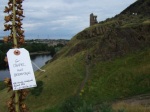


In her diary, Dorothy Wordsworth, visiting the city with her brother William, mentions St Anthony’s Chapel in Holyrood Park. The Wordsworths had made a journey from their home in the Lake District to Scotland, initially accompanied by Coleridge too, but he went his own way in the Highlands. Returning south, they reached Edinburgh on Thursday 15 September, 1803, and stayed at the White Hart Inn in the Grassmarket, which Dorothy described as “not noisy, and tolerably cheap”. The following morning they set out from the Grassmarket in the direction of Holyrood. She writes:
‘We set out upon our walk, and went through many streets to Holyrood House, and thence to the hill called Arthur’s Seat, a high hill, very rocky at the top, and below covered with smooth turf, on which sheep were feeding. We climbed up till we came to St. Anthony’s Well and Chapel, as it is called, but it is more like a hermitage than a chapel, – a small ruin, which from its situation is exceedingly interesting, though in itself not remarkable. We sat down on a stone not far from the chapel, overlooking a pastoral hollow as wild and solitary as any in the heart of the Highland mountains: there, instead of the roaring of torrents, we listened to the noises of the city, which were blended in one loud indistinct buzz, – a regular sound in the air, which in certain moods of feeling, and at certain times, might have a more tranquillizing effect upon the mind than those which we are accustomed to hear in such places.’



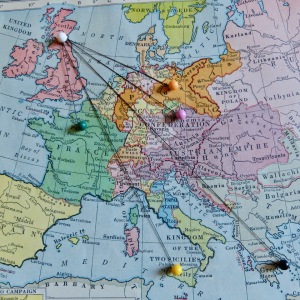

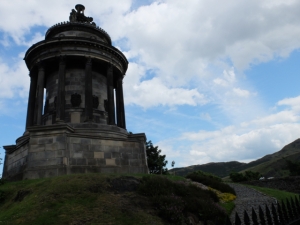
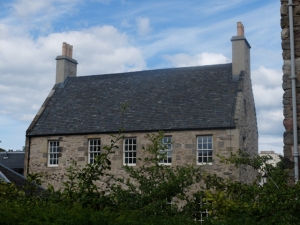
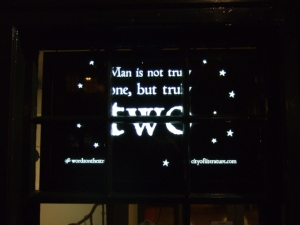

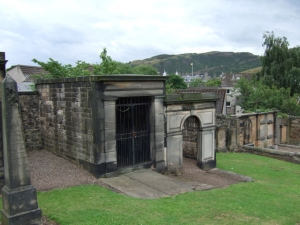





















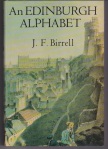 This Edinburgh Alphabet features poems (and some prose) about the city; I’m posting it on
This Edinburgh Alphabet features poems (and some prose) about the city; I’m posting it on 

